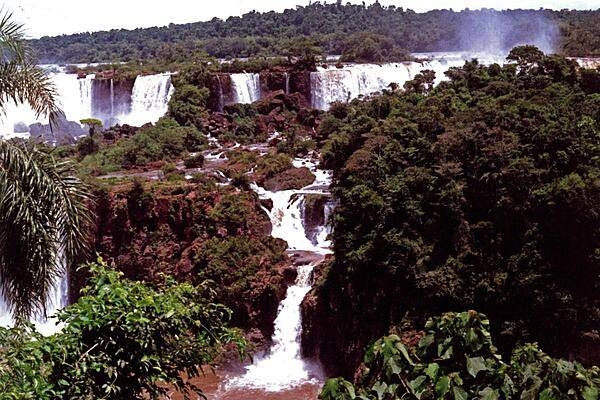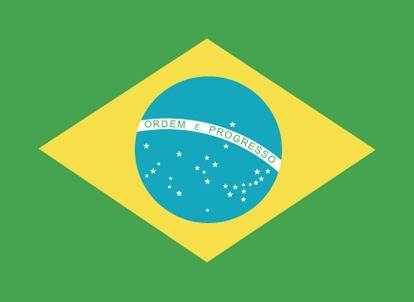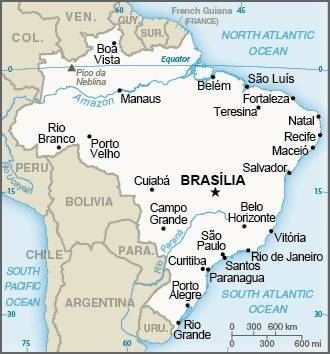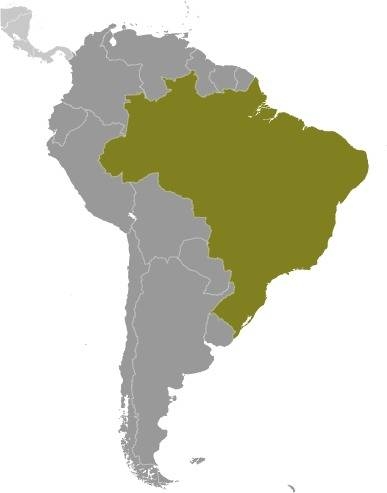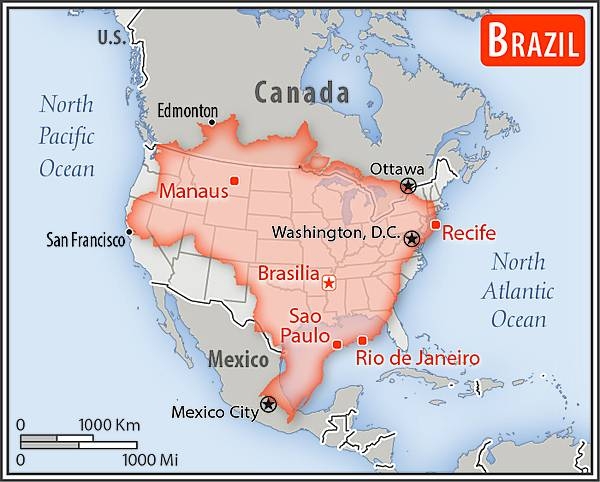Introduction
Background
Following more than three centuries under Portuguese rule, Brazil gained its independence in 1822, maintaining a monarchical system of government until the abolition of slavery in 1888 and the subsequent proclamation of a republic by the military in 1889. Brazilian coffee exporters politically dominated the country until populist leader Getulio VARGAS rose to power in 1930. VARGAS governed over various versions of democratic and authoritarian regimes from 1930 to 1945. Democratic rule returned (including a democratically elected VARGAS administration from 1951 to 1955) and lasted until 1964, when the military overthrew President Joao GOULART. The military regime censored journalists and repressed and tortured dissidents in the late 1960s and early 1970s. The dictatorship lasted until 1985, when the military regime peacefully ceded power to civilian rulers, and the Brazilian Congress passed its current constitution in 1989.
By far the largest and most populous country in South America, Brazil continues to pursue industrial and agricultural growth and development of its interior. Having successfully weathered a period of global financial difficulty in the late 20th century, under President Luiz Inacio LULA da Silva (2003-2010) Brazil was seen as one of the world's strongest emerging markets and a contributor to global growth. The awarding of the 2014 FIFA World Cup and 2016 Summer Olympic Games, the first ever to be held in South America, was symbolic of the country's rise. However, from about 2013 to 2016, Brazil was plagued by a sagging economy, high unemployment, and high inflation, only emerging from recession in 2017. Former President Dilma ROUSSEFF (2011-2016) was removed from office in 2016 by Congress for having committed impeachable acts against Brazil's budgetary laws, and her vice president, Michel TEMER, served the remainder of her second term. A money-laundering investigation, Operation Lava Jato, uncovered a vast corruption scheme and prosecutors charged several high-profile Brazilian politicians with crimes. Former-President LULA was convicted of accepting bribes and served jail time (2018-19), although his conviction was overturned in early 2021. LULA's revival became complete in October 2022 when he narrowly defeated incumbent Jair BOLSONARO (2019-2022) in the presidential election. LULA will assume the office on 1 January 2023.
Visit the Definitions and Notes page to view a description of each topic.
Geography
Location
Eastern South America, bordering the Atlantic Ocean
Geographic coordinates
10 00 S, 55 00 W
Map references
South America
Area
total: 8,515,770 sq km
land: 8,358,140 sq km
water: 157,630 sq km
note: includes Arquipelago de Fernando de Noronha, Atol das Rocas, Ilha da Trindade, Ilhas Martin Vaz, and Penedos de Sao Pedro e Sao Paulo
Land boundaries
total: 16,145 km
border countries (10): Argentina 1,263 km; Bolivia 3,403 km; Colombia 1,790 km; French Guiana 649 km; Guyana 1,308 km; Paraguay 1,371 km; Peru 2,659 km; Suriname 515 km; Uruguay 1,050 km; Venezuela 2,137 km
Coastline
7,491 km
Maritime claims
territorial sea: 12 nm
contiguous zone: 24 nm
exclusive economic zone: 200 nm
continental shelf: 200 nm or to edge of the continental margin
Climate
mostly tropical, but temperate in south
Terrain
mostly flat to rolling lowlands in north; some plains, hills, mountains, and narrow coastal belt
Elevation
highest point: Pico da Neblina 2,994 m
lowest point: Atlantic Ocean 0 m
mean elevation: 320 m
Natural resources
alumina, bauxite, beryllium, gold, iron ore, manganese, nickel, niobium, phosphates, platinum, tantalum, tin, rare earth elements, uranium, petroleum, hydropower, timber
Land use
agricultural land: 32.9% (2018 est.)
arable land: 8.6% (2018 est.)
permanent crops: 0.8% (2018 est.)
permanent pasture: 23.5% (2018 est.)
forest: 61.9% (2018 est.)
other: 5.2% (2018 est.)
Irrigated land
69,029 sq km (2017)
Major lakes (area sq km)
fresh water lake(s): Lagoa dos Patos - 10,140 sq km
salt water lake(s): Lagoa Mirim (shared with Uruguay) - 2,970 sq km
Major rivers (by length in km)
Amazon river mouth (shared with Peru [s]) - 6,400 km; Rio de la Plata/Parana river source (shared with Paraguay, Argentina, and Uruguay [m]) - 4,880 km; Tocantins - 3,650 km; Sao Francisco - 3,180 km; Paraguay river source (shared with Argentina and Paraguay [m]) - 2,549 km; Rio Negro river mouth (shared with Colombia [s] and Venezuela) - 2,250 km; Uruguay river source (shared with Argentina and Uruguay [m]) - 1,610 km
note – [s] after country name indicates river source; [m] after country name indicates river mouth
Major watersheds (area sq km)
Atlantic Ocean drainage: Amazon (6,145,186 sq km), Orinoco (953,675 sq km), Paraná (2,582,704 sq km), São Francisco (617,814 sq km), Tocantins (764,213 sq km)
Major aquifers
Amazon Basin, Guarani Aquifer System, Maranhao Basin
Population distribution
the vast majority of people live along, or relatively near, the Atlantic coast in the east; the population core is in the southeast, anchored by the cities of Sao Paolo, Brasilia, and Rio de Janeiro
Natural hazards
recurring droughts in northeast; floods and occasional frost in south
Geography - note
note 1: largest country in South America and in the Southern Hemisphere; shares common boundaries with every South American country except Chile and Ecuador; most of the Pantanal, the world's largest tropical wetland, extends through the west central part of the country; shares Iguazu Falls, the world's largest waterfalls system, with Argentina
note 2: cassava (manioc) the sixth most important food crop in the world - after maize, rice, wheat, potatoes, and soybeans - seems to have originated in the west-central part of Brazil; pineapples are probably indigenous to the southern Brazil-Paraguay region
note 3: Rocas Atoll, located off the northeast coast of Brazil, is the only atoll in the South Atlantic.
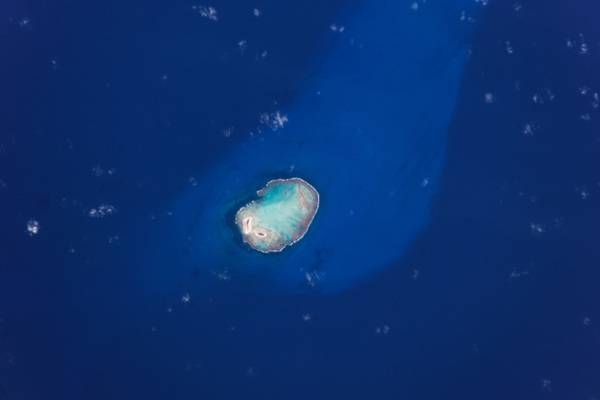
People and Society
Nationality
noun: Brazilian(s)
adjective: Brazilian
Ethnic groups
White 47.7%, mixed 43.1%, Black 7.6%, Asian 1.1%, Indigenous 0.4% (2010 est.)
Languages
Portuguese (official and most widely spoken language); note - less common languages include Spanish (border areas and schools), German, Italian, Japanese, English, and a large number of minor Amerindian languages
major-language sample(s):
O Livro de Fatos Mundiais, a fonte indispensável para informação básica. (Brazilian Portuguese)
The World Factbook, the indispensable source for basic information.
Religions
Roman Catholic 64.6%, other Catholic 0.4%, Protestant 22.2% (includes Adventist 6.5%, Assembly of God 2.0%, Christian Congregation of Brazil 1.2%, Universal Kingdom of God 1.0%, other Protestant 11.5%), other Christian 0.7%, Spiritist 2.2%, other 1.4%, none 8%, unspecified 0.4% (2010 est.)
Demographic profile
Brazil's rapid fertility decline since the 1960s is the main factor behind the country's slowing population growth rate, aging population, and fast-paced demographic transition. Brasilia has not taken full advantage of its large working-age population to develop its human capital and strengthen its social and economic institutions but is funding a study abroad program to bring advanced skills back to the country. The current favorable age structure will begin to shift around 2025, with the labor force shrinking and the elderly starting to compose an increasing share of the total population. Well-funded public pensions have nearly wiped out poverty among the elderly, and Bolsa Familia and other social programs have lifted tens of millions out of poverty. More than half of Brazil's population is considered middle class, but poverty and income inequality levels remain high; the Northeast, North, and Center-West, women, and black, mixed race, and indigenous populations are disproportionately affected. Disparities in opportunities foster social exclusion and contribute to Brazil's high crime rate, particularly violent crime in cities and favelas (slums).
Brazil has traditionally been a net recipient of immigrants, with its southeast being the prime destination. After the importation of African slaves was outlawed in the mid-19th century, Brazil sought Europeans (Italians, Portuguese, Spaniards, and Germans) and later Asians (Japanese) to work in agriculture, especially coffee cultivation. Recent immigrants come mainly from Argentina, Chile, and Andean countries (many are unskilled illegal migrants) or are returning Brazilian nationals. Since Brazil's economic downturn in the 1980s, emigration to the United States, Europe, and Japan has been rising but is negligible relative to Brazil's total population. The majority of these emigrants are well-educated and middle-class. Fewer Brazilian peasants are emigrating to neighboring countries to take up agricultural work.
Age structure
0-14 years: 21.11% (male 22,790,634/female 21,907,018)
15-24 years: 16.06% (male 17,254,363/female 16,750,581)
25-54 years: 43.83% (male 46,070,240/female 46,729,640)
55-64 years: 9.78% (male 9,802,995/female 10,911,140)
65 years and over: 9.21% (male 8,323,344/female 11,176,018) (2020 est.)
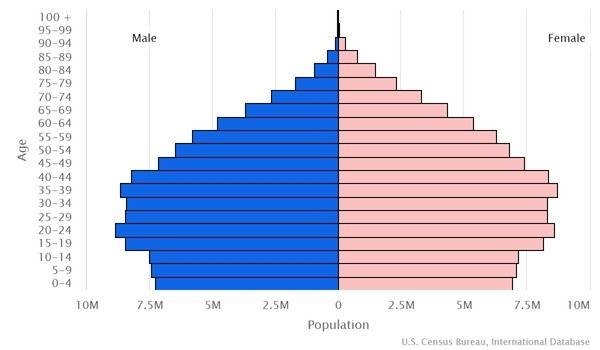
Dependency ratios
total dependency ratio: 43.1
youth dependency ratio: 29.4
elderly dependency ratio: 13.7
potential support ratio: 7.3 (2021 est.)
Median age
total: 33.2 years
male: 32.3 years
female: 34.1 years (2020 est.)
Population distribution
the vast majority of people live along, or relatively near, the Atlantic coast in the east; the population core is in the southeast, anchored by the cities of Sao Paolo, Brasilia, and Rio de Janeiro
Urbanization
urban population: 87.8% of total population (2023)
rate of urbanization: 0.87% annual rate of change (2020-25 est.)
Major urban areas - population
22.620 million Sao Paulo, 13.728 million Rio de Janeiro, 6.248 million Belo Horizonte, 4.873 million BRASILIA (capital), 4.264 million Recife, 4.212 million Porto Alegre (2023)
Sex ratio
at birth: 1.05 male(s)/female
0-14 years: 1.04 male(s)/female
15-24 years: 1.03 male(s)/female
25-54 years: 0.98 male(s)/female
55-64 years: 0.9 male(s)/female
65 years and over: 0.58 male(s)/female
total population: 0.97 male(s)/female (2022 est.)
Maternal mortality ratio
60 deaths/100,000 live births (2017 est.)
country comparison to the world: 88Infant mortality rate
total: 13.31 deaths/1,000 live births
male: 14.75 deaths/1,000 live births
female: 11.8 deaths/1,000 live births (2022 est.)
Life expectancy at birth
total population: 75.92 years
male: 72.5 years
female: 79.5 years (2022 est.)
Contraceptive prevalence rate
80.5% (2019)
Drinking water source
improved: urban: 99.8% of population
rural: 96.9% of population
total: 99.4% of population
unimproved: urban: 0.2% of population
rural: 3.1% of population
total: 0.6% of population (2020 est.)
Current health expenditure
9.6% of GDP (2019)
Physicians density
2.31 physicians/1,000 population (2019)
Hospital bed density
2.1 beds/1,000 population (2017)
Sanitation facility access
improved: urban: 94.1% of population
rural: 63.6% of population
total: 90.2% of population
unimproved: urban: 5.9% of population
rural: 36.4% of population
total: 9.8% of population (2020 est.)
Major infectious diseases
degree of risk: very high (2020)
food or waterborne diseases: bacterial diarrhea and hepatitis A
vectorborne diseases: dengue fever and malaria
water contact diseases: schistosomiasis
note: widespread ongoing transmission of a respiratory illness caused by the novel coronavirus (COVID-19) is occurring throughout Brazil; as of 9 December 2022, Brazil has reported a total of 35,497,781 cases of COVID-19 or 16,700.2 cumulative cases of COVID-19 per 100,000 population with a total of 690,577 cumulative deaths or a rate 324.9 cumulative deaths per 100,000 population; as of 7 December 2022, 87.36% of the population has received at least one dose of COVID-19 vaccine
Alcohol consumption per capita
total: 6.12 liters of pure alcohol (2019 est.)
beer: 3.84 liters of pure alcohol (2019 est.)
wine: 0.24 liters of pure alcohol (2019 est.)
spirits: 2 liters of pure alcohol (2019 est.)
other alcohols: 0.04 liters of pure alcohol (2019 est.)
Tobacco use
total: 12.8% (2020 est.)
male: 16.2% (2020 est.)
female: 9.4% (2020 est.)
Literacy
definition: age 15 and over can read and write
total population: 93.2%
male: 93%
female: 93.4% (2018)
School life expectancy (primary to tertiary education)
total: 16 years
male: 15 years
female: 16 years (2020)
Youth unemployment rate (ages 15-24)
total: 28.5%
male: 24.4%
female: 33.9% (2021 est.)
Environment
Environment - current issues
deforestation in Amazon Basin destroys the habitat and endangers a multitude of plant and animal species indigenous to the area; illegal wildlife trade; illegal poaching; air and water pollution in Rio de Janeiro, Sao Paulo, and several other large cities; land degradation and water pollution caused by improper mining activities; wetland degradation; severe oil spills
Environment - international agreements
party to: Antarctic-Environmental Protection, Antarctic-Marine Living Resources, Antarctic Seals, Antarctic Treaty, Biodiversity, Climate Change, Climate Change-Kyoto Protocol, Climate Change-Paris Agreement, Comprehensive Nuclear Test Ban, Desertification, Endangered Species, Environmental Modification, Hazardous Wastes, Law of the Sea, Marine Dumping-London Convention, Nuclear Test Ban, Ozone Layer Protection, Ship Pollution, Tropical Timber 2006, Wetlands, Whaling
signed, but not ratified: Marine Dumping-London Protocol
Air pollutants
particulate matter emissions: 11.49 micrograms per cubic meter (2016 est.)
carbon dioxide emissions: 462.3 megatons (2016 est.)
methane emissions: 401.83 megatons (2020 est.)
Climate
mostly tropical, but temperate in south
Land use
agricultural land: 32.9% (2018 est.)
arable land: 8.6% (2018 est.)
permanent crops: 0.8% (2018 est.)
permanent pasture: 23.5% (2018 est.)
forest: 61.9% (2018 est.)
other: 5.2% (2018 est.)
Urbanization
urban population: 87.8% of total population (2023)
rate of urbanization: 0.87% annual rate of change (2020-25 est.)
Revenue from forest resources
forest revenues: 0.62% of GDP (2018 est.)
country comparison to the world: 61Major infectious diseases
degree of risk: very high (2020)
food or waterborne diseases: bacterial diarrhea and hepatitis A
vectorborne diseases: dengue fever and malaria
water contact diseases: schistosomiasis
note: widespread ongoing transmission of a respiratory illness caused by the novel coronavirus (COVID-19) is occurring throughout Brazil; as of 9 December 2022, Brazil has reported a total of 35,497,781 cases of COVID-19 or 16,700.2 cumulative cases of COVID-19 per 100,000 population with a total of 690,577 cumulative deaths or a rate 324.9 cumulative deaths per 100,000 population; as of 7 December 2022, 87.36% of the population has received at least one dose of COVID-19 vaccine
Waste and recycling
municipal solid waste generated annually: 79,889,010 tons (2015 est.)
municipal solid waste recycled annually: 1,118,446 tons (2014 est.)
percent of municipal solid waste recycled: 1.4% (2014 est.)
Major lakes (area sq km)
fresh water lake(s): Lagoa dos Patos - 10,140 sq km
salt water lake(s): Lagoa Mirim (shared with Uruguay) - 2,970 sq km
Major rivers (by length in km)
Amazon river mouth (shared with Peru [s]) - 6,400 km; Rio de la Plata/Parana river source (shared with Paraguay, Argentina, and Uruguay [m]) - 4,880 km; Tocantins - 3,650 km; Sao Francisco - 3,180 km; Paraguay river source (shared with Argentina and Paraguay [m]) - 2,549 km; Rio Negro river mouth (shared with Colombia [s] and Venezuela) - 2,250 km; Uruguay river source (shared with Argentina and Uruguay [m]) - 1,610 km
note – [s] after country name indicates river source; [m] after country name indicates river mouth
Major watersheds (area sq km)
Atlantic Ocean drainage: Amazon (6,145,186 sq km), Orinoco (953,675 sq km), Paraná (2,582,704 sq km), São Francisco (617,814 sq km), Tocantins (764,213 sq km)
Major aquifers
Amazon Basin, Guarani Aquifer System, Maranhao Basin
Total water withdrawal
municipal: 16.74 billion cubic meters (2017 est.)
industrial: 9.511 billion cubic meters (2017 est.)
agricultural: 39.43 billion cubic meters (2017 est.)
Total renewable water resources
8.647 trillion cubic meters (2017 est.)
Government
Country name
conventional long form: Federative Republic of Brazil
conventional short form: Brazil
local long form: Republica Federativa do Brasil
local short form: Brasil
etymology: the country name derives from the brazilwood tree that used to grow plentifully along the coast of Brazil and that was used to produce a deep red dye
Government type
federal presidential republic
Capital
name: Brasilia
geographic coordinates: 15 47 S, 47 55 W
time difference: UTC-3 (2 hours ahead of Washington, DC, during Standard Time)
time zone note: Brazil has four time zones, including one for the Fernando de Noronha Islands
etymology: name bestowed on the new capital of Brazil upon its inauguration in 1960; previous Brazilian capitals had been Salvador from 1549 to 1763 and Rio de Janeiro from 1763 to 1960
Administrative divisions
26 states (estados, singular - estado) and 1 federal district* (distrito federal); Acre, Alagoas, Amapa, Amazonas, Bahia, Ceara, Distrito Federal*, Espirito Santo, Goias, Maranhao, Mato Grosso, Mato Grosso do Sul, Minas Gerais, Para, Paraiba, Parana, Pernambuco, Piaui, Rio de Janeiro, Rio Grande do Norte, Rio Grande do Sul, Rondonia, Roraima, Santa Catarina, Sao Paulo, Sergipe, Tocantins
Independence
7 September 1822 (from Portugal)
National holiday
Independence Day, 7 September (1822)
Constitution
history: several previous; latest ratified 5 October 1988
amendments: proposed by at least one third of either house of the National Congress, by the president of the republic, or by simple majority vote by more than half of the state legislative assemblies; passage requires at least three-fifths majority vote by both houses in each of two readings; constitutional provisions affecting the federal form of government, separation of powers, suffrage, or individual rights and guarantees cannot be amended; amended many times, last in 2021
Legal system
civil law; note - a new civil law code was enacted in 2002 replacing the 1916 code
International law organization participation
has not submitted an ICJ jurisdiction declaration; accepts ICCt jurisdiction
Citizenship
citizenship by birth: yes
citizenship by descent only: yes
dual citizenship recognized: yes
residency requirement for naturalization: 4 years
Suffrage
voluntary between 16 to 18 years of age, over 70, and if illiterate; compulsory between 18 to 70 years of age; note - military conscripts by law cannot vote
Executive branch
chief of state: President Jair BOLSONARO (since 1 January 2019); Vice President Antonio Hamilton Martins MOURAO (since 1 January 2019); note - the president is both chief of state and head of government
head of government: President Jair BOLSONARO (since 1 January 2019); Vice President Antonio Hamilton Martins MOURAO (since 1 January 2019)
cabinet: Cabinet appointed by the president
elections/appointments: president and vice president directly elected on the same ballot by absolute majority popular vote in 2 rounds if needed for a single 4-year term (eligible for an immediate second term, and additional terms after a one-term break); election last held on 2 October 2022 with runoff on 30 October 2022 (next to be held on 4 October 2026)
election results:
2022: Luiz Inacio LULA da Silva elected president in second round; percent of vote in first round - Luiz Inacio LULA da Silva (PT) 48.4%, Jair BOLSONARO (PSL) 43.2%, Simone TEBET (MDB) 4.2%, Ciro GOMES (PDT) 3%, other 1.2%; percent of vote in second round - Luiz Inacio LULA da Silva (PT) 50.9%, Jair BOLSONARO (PSL) 49.1%; note - LULA will take office 1 January 2023
2018: Jair BOLSONARO elected president in second round; percent of vote in first round - Jair BOLSONARO (PSL) 46%, Fernando HADDAD (PT) 29.3%, Ciro GOMEZ (PDT) 12.5%, Geraldo ALCKMIN (PSDB) 4.8%, other 7.4%; percent of vote in second round - Jair BOLSONARO (PSL) 55.1%, Fernando HADDAD (PT) 44.9%
2014: Dilma ROUSSEFF reelected president in second round; percent of vote in second round - Dilma ROUSSEFF (PT) 51.6%, Aecio NEVES (PSDB) 48.4%; note - on 12 May 2016, Brazil's Senate voted to hold an impeachment trial of President Dilma ROUSSEFF, who was then suspended from her executive duties; Vice President Michel TEMER took over as acting president; on 31 August 2016 the Senate voted 61-20 in favor of conviction and her removal from office; TEMER served as president for the remainder of ROUSSEFF's term, which ended 1 January 2019
Legislative branch
description: bicameral National Congress or Congresso Nacional consists of:
Federal Senate or Senado Federal (81 seats; 3 members each from 26 states and 3 from the federal district directly elected in multi-seat constituencies by simple majority vote to serve 8-year terms, with one-third and two-thirds of the membership elected alternately every 4 years)
Chamber of Deputies or Camara dos Deputados (513 seats; members directly elected in multi-seat constituencies by party-list proportional representation vote to serve 4-year terms)
elections:
Federal Senate - last held on 2 October 2022 for one-third of the Senate (next to be held on 4 October 2026 for two-thirds of the Senate)
Chamber of Deputies - last held on 2 October 2022 (next to be held on 4 October 2026)
election results:
Federal Senate - percent of vote by party - NA; seats by party - PL 8, Brazil Union 5, PT 4, Progressistas 3, PSD 2, Republican 2, MBD 1, PSB 1, PSC 1; note - complete Federal Senate compostion after 2022 election - PL 13, Brazil Union 12, MBD 10, PSD 10, PT 9, Progressistas 7, Podemos 6, PSDB 4, Republicans 3, PDT 2, Cidadania 1, PSB 1, PSC 1, PROS 1, REDE 1
Chamber of Deputies - percent of vote by party - NA; seats by party - PL 99, PT 67, Brazil Union 59, PP 47, MDB 42, PSD 42, Republicans 41, PDT 17, PSB 14, PSDB 13, Podemos 12, PSOL 12, Avante 7, PCdoB 6, PSC 6, PV 6, Cidadania 5, Patriota 4, PROS 4, SD 4, NOVO 3, REDE 2, PTB 1
Judicial branch
highest court(s): Supreme Federal Court or Supremo Tribunal Federal (consists of 11 justices)
judge selection and term of office: justices appointed by the president and approved by the Federal Senate; justices appointed to serve until mandatory retirement at age 75
subordinate courts: Tribunal of the Union, Federal Appeals Court, Superior Court of Justice, Superior Electoral Court, regional federal courts; state court system
Political parties and leaders
Act (Agir) [Daniel TOURINHO] (formerly Christian Labor Party or PTC)
Avante [Luis Henrique de Oliveira RESENDE] (formerly Labor Party of Brazil or PTdoB)
Brazil Union (Uniao Brasil); note - founded from a merger between the Democrats (DEM) and the Social Liberal Party (PSL)
Brazilian Communist Party or PCB [Astrogildo PEREIRA]
Brazilian Democratic Movement or MDB [Luiz Felipe Baleia TENUTO Rossi]
Brazilian Labor Party or PTB [Kassyo Santos RAMOS]
Brazilian Renewal Labor Party or PRTB [Aiceia RODRIGUES and Hamilton MOURAO]
Brazilian Labor Party or PTB
Brazilian Social Democracy Party or PSDB [Bruno ARAUJO]
Brazilian Socialist Party or PSB [Carlos Roberto SIQUEIRA de Barros]
Christian Democracy or DC [Jose Maria EYMAEL] (formerly Christian Social
Cidadania [Roberto Joao Pereira FREIRE] (formerly Popular Socialist Party or PPS)
Communist Party of Brazil or PCdoB [Luciana SANTOS]
Democratic Labor Party or PDT [Carlos LUPI]
Democratic Party or PSDC
Democrats or DEM [Jose AGRIPINO] (formerly Liberal Front Party or PFL); note - dissolved in February 2022
Green Party or PV [Jose Luiz PENNA]
Liberal Party or PL [Luciano BIVAR and Antonio de RUEDA] (formerly Party of the Republic or PR)
National Mobilization Party or PMN [Antonio Carlos Bosco MASSAROLLO]
New Party or NOVO [Eduardo RIBEIRO]
Patriota [Adilson BAROSSO Oliveira] (formerly National Ecologic Party or PEN)
Podemos [Renata ABREU] (formerly National Labor Party or PTN)
Progressive Party (Progressistas) or PP [Ciro NOGUEIRA]
Republican Social Order Party or PROS [Euripedes JUNIOR]
Republicans (Republicanos) [Marcos Antonio PEREIRA] (formerly Brazilian Republican Party or PRB)
Social Christian Party or PSC [Everaldo Dias PEREIRA]
Social Democratic Party or PSD [Alfredo COATIT Neto]
Social Liberal Party or PSL [Luciano Caldas BIVAR]
Socialism and Freedom Party or PSOL [Juliano MEDEIROS]
Solidarity or SD [Paulinho DA FORCA]
Sustainability Network or REDE [Marina SILVA]
United Socialist Workers' Party or PSTU [Jose Maria DE ALMEIDA]
Workers' Cause Party or PCO [Rui Costa PIMENTA]
Workers' Party or PT [Gleisi HOFFMANN]
International organization participation
AfDB (nonregional member), BIS, BRICS, CAN (associate), CD, CELAC, CPLP, FAO, FATF, G-15, G-20, G-24, G-5, G-77, IADB, IAEA, IBRD, ICAO, ICC (national committees), ICCt, ICRM, IDA, IFAD, IFC, IFRCS, IHO, ILO, IMF, IMO, IMSO, Interpol, IOC, IOM, IPU, ISO, ITSO, ITU, ITUC (NGOs), LAES, LAIA, LAS (observer), Mercosur, MIGA, MINURSO, MINUSTAH, MONUSCO, NAM (observer), NSG, OAS, OECD (enhanced engagement), OPANAL, OPCW, Paris Club (associate), PCA, PROSUR, SICA (observer), UN, UNASUR, UNCTAD, UNESCO, UNFICYP, UNHCR, UNHRC, UNIDO, UNISFA, UNIFIL, Union Latina, UNISFA, UNITAR, UNMIL, UNMISS, UNOCI, UNRWA, UNWTO, UPU, WCO, WFTU (NGOs), WHO, WIPO, WMO, WTO
Diplomatic representation in the US
chief of mission: Ambassador Nestor Jose FORSTER, Jr. (since 23 December 2020)
chancery: 3006 Massachusetts Avenue NW, Washington, DC 20008
telephone: [1] (202) 238-2700
FAX: [1] (202) 238-2827
email address and website:
http://washington.itamaraty.gov.br/en-us/Main.xml
consulate(s) general: Atlanta, Boston, Chicago, Hartford (CT), Houston, Los Angeles, Miami, New York, San Francisco, Washington, DC
Diplomatic representation from the US
chief of mission: Ambassador (vacant); Charge d'Affaires Douglas A. KONEFF (since July 2021)
embassy: SES - Avenida das Nacoes, Quadra 801, Lote 3, 70403-900 - Brasilia, DF
mailing address: 7500 Brasilia Place, Washington DC 20521-7500
telephone: [55] (61) 3312-7000
FAX: [55] (61) 3225-9136
email address and website:
BrasilliaACS@state.gov
https://br.usembassy.gov/
consulate(s) general: Recife, Porto Alegre, Rio de Janeiro, Sao Paulo
branch office(s): Belo Horizonte
Flag description
green with a large yellow diamond in the center bearing a blue celestial globe with 27 white five-pointed stars; the globe has a white equatorial band with the motto ORDEM E PROGRESSO (Order and Progress); the current flag was inspired by the banner of the former Empire of Brazil (1822-1889); on the imperial flag, the green represented the House of Braganza of Pedro I, the first Emperor of Brazil, while the yellow stood for the Habsburg Family of his wife; on the modern flag the green represents the forests of the country and the yellow rhombus its mineral wealth (the diamond shape roughly mirrors that of the country); the blue circle and stars, which replaced the coat of arms of the original flag, depict the sky over Rio de Janeiro on the morning of 15 November 1889 - the day the Republic of Brazil was declared; the number of stars has changed with the creation of new states and has risen from an original 21 to the current 27 (one for each state and the Federal District)
note: one of several flags where a prominent component of the design reflects the shape of the country; other such flags are those of Bosnia and Herzegovina, Eritrea, and Vanuatu
National symbol(s)
Southern Cross constellation; national colors: green, yellow, blue
National anthem
name: "Hino Nacional Brasileiro" (Brazilian National Anthem)
lyrics/music: Joaquim Osorio Duque ESTRADA/Francisco Manoel DA SILVA
note: music adopted 1890, lyrics adopted 1922; the anthem's music, composed in 1822, was used unofficially for many years before it was adopted
National heritage
total World Heritage Sites: 23 (15 cultural, 7 natural, 1 mixed)
selected World Heritage Site locales: Brasilia (c); Historic Salvador de Bahia (c); Historic Ouro Preto (c); Historic Olinda (c); Iguaçu National Park (n); Jesuit Missions of the Guaranis (c); Rio de Janeiro: Carioca Landscapes (c); Central Amazon Conservation Complex (n); Atlantic Forest South-East Reserves (n); Paraty and Ilha Grande – Culture and Biodiversity (m)
Economy
Economic overview
Brazil is the eighth-largest economy in the world, but is recovering from a recession in 2015 and 2016 that ranks as the worst in the country’s history. In 2017, Brazil`s GDP grew 1%, inflation fell to historic lows of 2.9%, and the Central Bank lowered benchmark interest rates from 13.75% in 2016 to 7%.
The economy has been negatively affected by multiple corruption scandals involving private companies and government officials, including the impeachment and conviction of Former President Dilma ROUSSEFF in August 2016. Sanctions against the firms involved — some of the largest in Brazil — have limited their business opportunities, producing a ripple effect on associated businesses and contractors but creating opportunities for foreign companies to step into what had been a closed market.
The succeeding TEMER administration has implemented a series of fiscal and structural reforms to restore credibility to government finances. Congress approved legislation in December 2016 to cap public spending. Government spending growth had pushed public debt to 73.7% of GDP at the end of 2017, up from over 50% in 2012. The government also boosted infrastructure projects, such as oil and natural gas auctions, in part to raise revenues. Other economic reforms, proposed in 2016, aim to reduce barriers to foreign investment, and to improve labor conditions. Policies to strengthen Brazil’s workforce and industrial sector, such as local content requirements, have boosted employment, but at the expense of investment.
Brazil is a member of the Common Market of the South (Mercosur), a trade bloc that includes Argentina, Paraguay and Uruguay - Venezuela’s membership in the organization was suspended In August 2017. After the Asian and Russian financial crises, Mercosur adopted a protectionist stance to guard against exposure to volatile foreign markets and it currently is negotiating Free Trade Agreements with the European Union and Canada.
Real GDP (purchasing power parity)
$2,989,430,000,000 (2020 est.)
$3,115,910,000,000 (2019 est.)
$3,072,550,000,000 (2018 est.)
note: data are in 2017 dollars
Real GDP growth rate
1.13% (2019 est.)
1.2% (2018 est.)
1.62% (2017 est.)
Real GDP per capita
$14,100 (2020 est.)
$14,800 (2019 est.)
$14,700 (2018 est.)
note: data are in 2017 dollars
GDP (official exchange rate)
$1,877,942,000,000 (2019 est.)
Inflation rate (consumer prices)
3.7% (2019 est.)
3.6% (2018 est.)
3.4% (2017 est.)
Credit ratings
Fitch rating: BB- (2018)
Moody's rating: Ba2 (2016)
Standard & Poors rating: BB- (2018)
note: The year refers to the year in which the current credit rating was first obtained.
GDP - composition, by sector of origin
agriculture: 6.6% (2017 est.)
industry: 20.7% (2017 est.)
services: 72.7% (2017 est.)
GDP - composition, by end use
household consumption: 63.4% (2017 est.)
government consumption: 20% (2017 est.)
investment in fixed capital: 15.6% (2017 est.)
investment in inventories: -0.1% (2017 est.)
exports of goods and services: 12.6% (2017 est.)
imports of goods and services: -11.6% (2017 est.)
Agricultural products
sugar cane, soybeans, maize, milk, cassava, oranges, poultry, rice, beef, cotton
Industries
textiles, shoes, chemicals, cement, lumber, iron ore, tin, steel, aircraft, motor vehicles and parts, other machinery and equipment
Labor force - by occupation
agriculture: 9.4%
industry: 32.1%
services: 58.5% (2017 est.)
Youth unemployment rate (ages 15-24)
total: 28.5%
male: 24.4%
female: 33.9% (2021 est.)
Population below poverty line
4.2% (2016 est.)
note: approximately 4% of the population are below the "extreme" poverty line
Gini Index coefficient - distribution of family income
53.9 (2018 est.)
54 (2004)
Household income or consumption by percentage share
lowest 10%: 0.8%
highest 10%: 43.4% (2016 est.)
Budget
revenues: 733.7 billion (2017 est.)
expenditures: 756.3 billion (2017 est.)
Fiscal year
calendar year
Current account balance
-$50.927 billion (2019 est.)
-$41.54 billion (2018 est.)
Exports
$239.18 billion (2020 est.)
$260.07 billion (2019 est.)
$274.9 billion (2018 est.)
note: Data are in current year dollars and do not include illicit exports or re-exports.
Exports - partners
China 28%, United States 13% (2019)
Exports - commodities
soybeans, crude petroleum, iron, corn, wood pulp products (2019)
Imports
$227.44 billion (2020 est.) note: data are in current year dollars
$269.02 billion (2019 est.) note: data are in current year dollars
$267.52 billion (2018 est.) note: data are in current year dollars
Imports - partners
China 21%, United States 18%, Germany 6%, Argentina 6% (2019)
Imports - commodities
refined petroleum, vehicle parts, crude petroleum, integrated circuits, pesticides (2019)
Reserves of foreign exchange and gold
$374 billion (31 December 2017 est.)
$367.5 billion (31 December 2016 est.)
Debt - external
$681.336 billion (2019 est.)
$660.693 billion (2018 est.)
Exchange rates
reals (BRL) per US dollar -
5.12745 (2020 est.)
4.14915 (2019 est.)
3.862 (2018 est.)
3.3315 (2014 est.)
2.3535 (2013 est.)
Energy
Electricity access
electrification - total population: 100% (2020)
Electricity
installed generating capacity: 195.037 million kW (2020 est.)
consumption: 540,997,340,000 kWh (2020 est.)
exports: 395 million kWh (2020 est.)
imports: 25.113 billion kWh (2020 est.)
transmission/distribution losses: 105.727 billion kWh (2020 est.)
Electricity generation sources
fossil fuels: 11.8% of total installed capacity (2020 est.)
nuclear: 2.3% of total installed capacity (2020 est.)
solar: 1.7% of total installed capacity (2020 est.)
wind: 9.2% of total installed capacity (2020 est.)
hydroelectricity: 65.8% of total installed capacity (2020 est.)
tide and wave: 0% of total installed capacity (2020 est.)
geothermal: 0% of total installed capacity (2020 est.)
biomass and waste: 9.2% of total installed capacity (2020 est.)
Coal
production: 13.993 million metric tons (2020 est.)
consumption: 31.841 million metric tons (2020 est.)
exports: 16,000 metric tons (2020 est.)
imports: 19.217 million metric tons (2020 est.)
proven reserves: 6.596 billion metric tons (2019 est.)
Petroleum
total petroleum production: 3,629,100 bbl/day (2021 est.)
refined petroleum consumption: 3,142,300 bbl/day (2019 est.)
crude oil and lease condensate exports: 1,123,300 bbl/day (2018 est.)
crude oil and lease condensate imports: 186,200 bbl/day (2018 est.)
crude oil estimated reserves: 12,714,600,000 barrels (2021 est.)
Refined petroleum products - production
2.811 million bbl/day (2015 est.)
country comparison to the world: 7Natural gas
production: 25,395,979,000 cubic meters (2019 est.)
consumption: 35,253,198,000 cubic meters (2019 est.)
exports: 0 cubic meters (2021 est.)
imports: 9,724,017,000 cubic meters (2019 est.)
proven reserves: 363.984 billion cubic meters (2021 est.)
Carbon dioxide emissions
456.67 million metric tonnes of CO2 (2019 est.)
from coal and metallurgical coke: 63.53 million metric tonnes of CO2 (2019 est.)
from petroleum and other liquids: 328.824 million metric tonnes of CO2 (2019 est.)
from consumed natural gas: 64.316 million metric tonnes of CO2 (2019 est.)
Energy consumption per capita
59.444 million Btu/person (2019 est.)
country comparison to the world: 93Communications
Telephones - fixed lines
total subscriptions: 30,653,813 (2020 est.)
subscriptions per 100 inhabitants: 14 (2020 est.)
Telephones - mobile cellular
total subscriptions: 205,834,781 (2020 est.)
subscriptions per 100 inhabitants: 97 (2020 est.)
Telecommunication systems
general assessment: Brazil is one of the largest mobile and broadband markets in Latin America with healthy competition and pricing; the development of 5G, was scheduled for March 2020 but was delayed due to interference issues with satellite TV broadcasts and the pandemic; the auction was completed November 2021; the licenses are obliged to provide 5G services to all capital cities by July 2022, as well as about 35,500km of the national highway network; the country also has one of the largest fixed line broadband markets in Latin America, though broadband subscriptions is only slightly above the regional average, trailing behind Chile, Argentina, and Uruguay; amendments to the licensing regime adopted in October 2019 also require that ISPs which have switched to authorizations invest money saved from lighter regulations in the expansion of broadband services; the fixed line broadband market has seen rapid growth for a number of years, with a growing focus on fiber broadband; in 2019 the number of fiber accesses overtook DSL connections; the country is a key landing point for a number of important submarine cables connecting to the US, Central and South America, the Caribbean, Europe, and Africa; several new cable systems are due to come into service through to 2022, which will increase bandwidth and push down broadband prices for end-users; investments have also been made into terrestrial fiber cables between Brazil, Argentina, and Chile (2021)
domestic: fixed-line connections stand at roughly 14 per 100 persons; less-expensive mobile-cellular technology has been a major impetus broadening telephone service to the lower-income segments of the population with mobile-cellular teledensity roughly 97 per 100 persons (2020)
international: country code - 55; landing points for a number of submarine cables, including Malbec, ARBR, Tamnat, SAC, SAm-1, Atlantis -2, Seabras-1, Monet, EllaLink, BRUSA, GlobeNet, AMX-1, Brazilian Festoon, Bicentenario, Unisur, Junior, Americas -II, SAE x1, SAIL, SACS and SABR that provide direct connectivity to South and Central America, the Caribbean, the US, Africa, and Europe; satellite earth stations - 3 Intelsat (Atlantic Ocean), 1 Inmarsat (Atlantic Ocean region east), connected by microwave relay system to Mercosur Brazilsat B3 satellite earth station; satellites is a major communication platform, as it is almost impossible to lay fiber optic cable in the thick vegetation (2019)
note: the COVID-19 pandemic continues to have a significant impact on production and supply chains globally; since 2020, some aspects of the telecom sector have experienced a downturn, particularly in mobile device production; progress toward 5G implementation has resumed, as well as upgrades to infrastructure; consumer spending on telecom services has increased due to the surge in demand for capacity and bandwidth; the crucial nature of telecom services as a tool for work and school from home is still evident, and the spike in this area has seen growth opportunities for development of new tools and increased services
Broadcast media
state-run Radiobras operates a radio and a TV network; more than 1,000 radio stations and more than 100 TV channels operating - mostly privately owned; private media ownership highly concentrated (2022)
Internet users
total: 172,173,121 (2020 est.)
percent of population: 81% (2020 est.)
Broadband - fixed subscriptions
total: 36,344,670 (2020 est.)
subscriptions per 100 inhabitants: 17 (2020 est.)
Transportation
National air transport system
number of registered air carriers: 9 (2020)
inventory of registered aircraft operated by air carriers: 443
annual passenger traffic on registered air carriers: 102,109,977 (2018)
annual freight traffic on registered air carriers: 1,845,650,000 (2018) mt-km
Airports - with paved runways
total: 698
over 3,047 m: 7
2,438 to 3,047 m: 27
1,524 to 2,437 m: 179
914 to 1,523 m: 436 (2017)
under 914 m: 49 (2021)
Airports - with unpaved runways
total: 3,395
1,524 to 2,437 m: 92
914 to 1,523 m: 1,619
under 914 m: 1,684 (2021)
Heliports
13 (2021)
Pipelines
5,959 km refined petroleum product (1,165 km distribution, 4,794 km transport), 11,696 km natural gas (2,274 km distribution, 9,422 km transport), 1,985 km crude oil (distribution), 77 km ethanol/petrochemical (37 km distribution, 40 km transport) (2016)
Railways
total: 29,849.9 km (2014)
standard gauge: 194 km (2014) 1.435-m gauge
narrow gauge: 23,341.6 km (2014) 1.000-m gauge (24 km electrified)
broad gauge: 5,822.3 km (2014) 1.600-m gauge (498.3 km electrified)
dual gauge: 492 km (2014) 1.600-1.000-m gauge
Roadways
total: 2 million km (2018)
paved: 246,000 km (2018)
unpaved: 1.754 million km (2018)
Waterways
50,000 km (2012) (most in areas remote from industry and population)
country comparison to the world: 2Merchant marine
total: 864
by type: bulk carrier 11, container ship 19, general cargo 42, oil tanker 31, other 761 (2021)
Ports and terminals
major seaport(s): Belem, Itajai, Paranagua, Rio Grande, Rio de Janeiro, Santos, Sao Sebastiao, Tubarao
oil terminal(s): DTSE/Gegua oil terminal, Ilha Grande (Gebig), Guaiba Island terminal, Guamare oil terminal
container port(s) (TEUs): Itajai (1,223,262), Paranagua (865,110), Santos (4,165,248) (2019)
LNG terminal(s) (import): Pecem, Rio de Janiero
river port(s): Manaus (Amazon)
dry bulk cargo port(s): Sepetiba ore terminal, Tubarao
Military and Security
Military and security forces
Brazilian Armed Forces (Forças Armadas Brasileiras): Brazilian Army (Exercito Brasileiro, EB), Brazilian Navy (Marinha do Brasil, MB, includes Naval Aviation (Aviacao Naval Brasileira) and Marine Corps (Corpo de Fuzileiros Navais)), Brazilian Air Force (Forca Aerea Brasileira, FAB) (2022)
Military expenditures
1.3% of GDP (2021 est.)
1.4% of GDP (2020)
1.4% of GDP (2019) (approximately $35.6 billion)
1.5% of GDP (2018) (approximately $36 billion)
1.4% of GDP (2017) (approximately $34.4 billion)
Military and security service personnel strengths
approximately 360,000 active military personnel (220,000 Army; 70,000 Navy; 70,000 Air Force) (2022)
Military equipment inventories and acquisitions
the Brazilian military's inventory consists of a mix of domestically-produced and imported weapons, largely from Europe and the US; since 2010, the US and several European countries are the leading suppliers of military equipment to Brazil; Brazil's defense industry is capable of designing and manufacturing equipment for all three military services and for export; it also jointly produces equipment with other countries (2022)
Military service age and obligation
18-45 years of age for compulsory military service for men (women exempted); only 5-10% of those inducted are required to serve; conscript service obligation is 10-12 months; 17-45 years of age for voluntary service (2022)
note: in 2020, women comprised approximately 9% of the Brazilian military
Military - note
the origins of Brazil's military stretch back to the 1640s
the three national police forces – the Federal Police, Federal Highway Police, and Federal Railway Police – have domestic security responsibilities and report to the Ministry of Justice and Public Security (Ministry of Justice); there are two distinct units within the state police forces: the civil police, which performs an investigative role, and the military police, charged with maintaining law and order in the states and the Federal District; despite the name, military police forces report to the Ministry of Justice, not the Ministry of Defense; the National Public Security Force (Forca Nacional de Seguranca Publica or SENASP) is a national police force made up of Military Police from various states; the armed forces also have some domestic security responsibilities and report to the Ministry of Defense
Brazil has Major Non-NATO Ally (MNNA) status with the US; MNNA is a designation under US law that provides foreign partners with certain benefits in the areas of defense trade and security cooperation; while MNNA status provides military and economic privileges, it does not entail any security commitments (2022)
Maritime threats
the International Maritime Bureau reports the territorial waters of Brazil are a risk for armed robbery against ships; in 2021, three attacks against commercial vessels were reported, a decrease from the seven attacks in 2020; all of these occurred in the port of Macapa while ships were berthed or at anchor
Terrorism
Terrorist group(s)
Hizballah (2022)
note: details about the history, aims, leadership, organization, areas of operation, tactics, targets, weapons, size, and sources of support of the group(s) appear(s) in Appendix-T
Transnational Issues
Disputes - international
Brazil-Bolivia: The Roboré Accord of March 29, 1958 placed the long-disputed Isla Suárez/Ilha de Guajará-Mirim, a fluvial island on the Río Mamoré, between the two towns of Guajará-Mirim (Brazil) and Guayaramerin (Bolivia), under Bolivian administration but did not resolve the sovereignty dispute
Brazil-Colombia: Contraband smuggling (narcotics and arms), illegal migration, trafficking in animals, plants, lumber, illegal exploitation of mineral resources, Colombian (FARC) insurgent incursions in the area remain problematic issues.
Brazil-Uruguay: The uncontested boundary dispute between Brazil and Uruguay over over Arroyo de la Invernada triangle and sovereignty over Isla Brasilera leaves the tripoint with Argentina in question. Smuggling of firearms and narcotics continues to be an issue along the Uruguay-Brazil border.
Brazil-Venezuela: Colombian-organized illegal narcotics and paramilitary activities penetrate Brazil's border region with Venezuela.
Refugees and internally displaced persons
refugees (country of origin): 261,441 (Venezuela) (economic and political crisis; includes Venezuelans who have claimed asylum, are recognized as refugees, or received alternative legal stay) (2020)
IDPs: 21,000
stateless persons: 14 (mid-year 2021)
Illicit drugs
a significant transit and destination country for cocaine; most of the cocaine enters Brazil from neighboring producing countries Bolivia, Colombia, and Peru then goes to West Africa and Europe, but an increasing percentage feeds substantial domestic drug consumption; second-largest consumer of cocaine hydrochloride and cocaine-derivative products in the world
